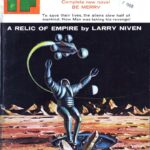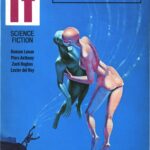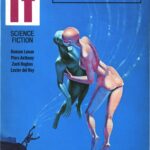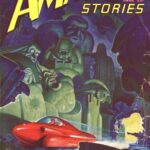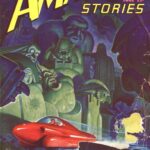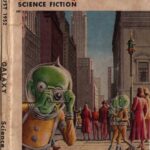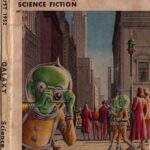One of my favourite genres of literature is science fiction. Two of the classic science fiction authors at the start of the previous century were H. G. Wells, Edgar Rice Burroughs and Jules Verne. The golden era of science fiction began in late 1930s and 1940s and flourished in the post-war era, which saw the big three (Issac Asimov, Arthur C. Clarke, and Robert Heinlein) along with many others bring out their finest. Some of the other remarkable authors from that era include (my personal preference, and by no means a representative list) Ray Bradbury, Philip K. Dick, Stanisław Lem, Frank Herbert, Ursula K. Le Guin, and Kurt Vonnegut. Though novels were there, the mass format was the pulp science fiction magazines which published short or serialised stories from various authors. Many of the famous novels were first published as short stories in these pulp magazines. A selection of them with fantastic full-colour covers and some with black and white illustrations on the inside. Some of the prominent titles that come up are Amazing Stories, Astounding Science Fiction, Worlds of IF, Galaxy Science fiction among others.
The post-war era was an era where people believed that we will have permanent bases on the Moon by end of the 20th century and space travel would be commonplace. But we now know, it will be perhaps a few decades if not centuries for space travel to become common. The optimism in the 50s and 60s perhaps was fuelled by the cold war space race, which saw both the West and Soviets invest huge sums to research and development in developing space technologies. This optimism gradually waned as the Soviet empire fell.
With television becoming the newest technology to reach out to the audience, it is not surprising that many of the programmes were tuned to science fiction. I happened to stumble upon one such programmes while scanning the treasures at The Internet Archive. This was a British production titled Quatermass and The Pit created by Nigel Kneale. This is third in a series of Quatermass episodes.
Warning: Spoilers ahead
The six-part television series from 1958 (each episode is 30-35 minutes) is set in post-war London at Hobbs lane where during an excavation for a building some fossil skulls are discovered. Dr. Matthew Roney, a paleontologist from a nearby museum begins to investigate the discovery. The fossil skulls and subsequent bones are found to be a new previously unknown dwarf hominid species, perhaps the missing link and are dated to roughly 5 MYA. Roney’s head assistant Barbara Judd, creates a reconstruction of the species which is present to the press.

Soon after, when they continue digging a strange smooth object is found in the pit. The object resembles an unexploded World War II-era bomb and police and subsequently, the military is contacted for its safe disposal.
The bomb disposal squad works slowly and does not care about the archaeological aspects of the pit. This makes Roney impatient, who then contacts his experimental physicist friend Prof. Bernard Quatermass to hasten the disposal of the bomb disposal squad.

Quartermass is involved in rocket research, which he intends to use for peaceful purposes. And this creates a rift between him and the military personnel he is working with. This has some moral and ethical implications for the purpose of scientific research and whether the scientists are responsible for their research being used for military purposes. The military intends to develop bases on the Moon and Mars in order to achieve supremacy in space which is against the principles of Quatermass.

Quatermass and Colonel Breen visit the site in order to look at the discovery. When the supposed bomb is excavated deeper more fossils are found and the true shape of the artefact is revealed. And it turns out that the artefact cannot be cut by gas cutter, even after raising the temperature to order of 3000 degrees.

Further digging, provides a disk and an opening to the artefact. Soon, the shape of the complete artefact is revealed. Rest of the hollow space is emptied out, yet the hull of the artefact remains close shut. There is a pentacle on the smooth inner surface of the hull.

From the outside, the artefact looks like a rocket, which leads Breen to speculate that it is indeed a German rocket which fell here during the war. Also, traces of artificial radioactivity are found in the soil, which indicates that the artefact might be propelled by a nuclear engine. But Quatermass taking into account the age of the fossils speculates that the artefact itself might be of ancient origin. One of the bomb-disposal unit member has a strange hallucinating experience inside the artefact. He sees a dwarf-like figure pass through the walls.

To open the hull, they try to drill it with a borazon boron nitride drill which makes no impact. But the action of the drills sets out weird vibrations which make everyone frightened and uneasy.

Everyone is in a state of panic after this. Quatermass, Roney, and Judd run a parallel investigation after hearing out an old local couple about the neigbouring house being haunted. They dig older records and find episodes of haunting dating back till 1300s through to the present. For Quatermass and Roney this is too much of a coincidence and they begin to speculate about the ancient origins of the artefact.
Just after the drilling, a hole automatically appears in the pentacled hull. Roney looks inside and sees what seems like an eye. They force open the hull and find three insects inside the hull who are decaying.

Roney immediately tries to stop the decay and preserves the specimens and takes them to the museum. They are unlike any insects known and are tripods. Quatermass and Roney speculate the extra-terrestrial origin of these insects, most probably from Mars.
When the drill operator is taking out his equipment, he triggers more poltergeist activity from the artefact and sets a panic across the street. He finally lands in a church in a state of delirium. He describes to Roney and Quatermass hallucinating visions of the insects found in the artefact killing each other.

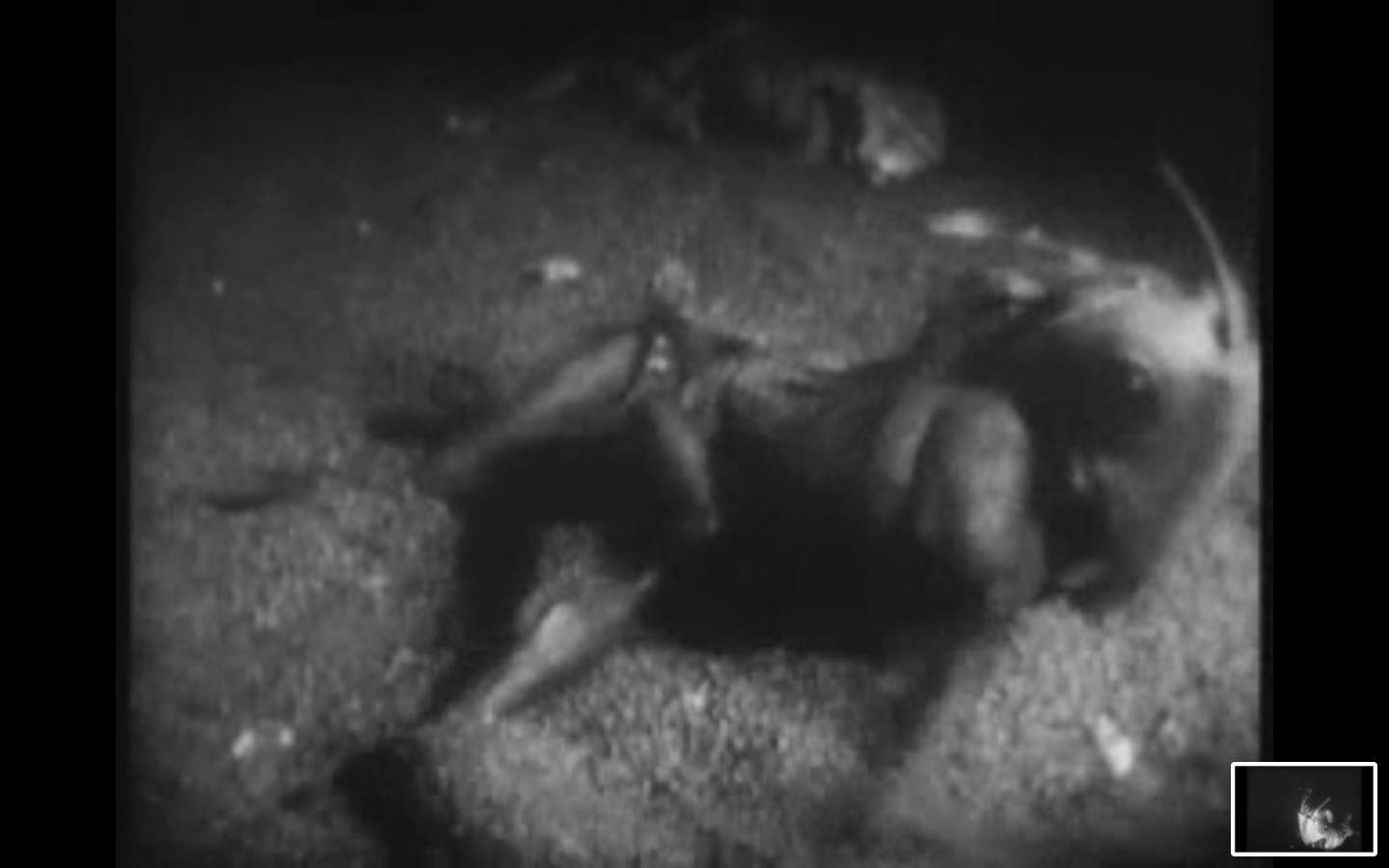
Like good scientists, they further investigate the visions using a Roney’s optic-encephalogram, a device that records impressions from the optical centers of the brain. It turns out Judd is the most sensitive of the lot to these visions and they record them. The visions show large-scale culling of the mutations of insects. Seeing these recordings as a “proof” of their theory of extra-terrestrial origins of the artefact. This evidence along with his theory is presented to the military brass. The theory is ridiculed as a fantasy, and a common-sense approach that artefact and the insects being propaganda from Nazi Germany is preferred. They want to dispel the myth that the artefact is that old or it is indeed extra-terrestrial.
The theory as developed by Quatermass is as follows taking into account the evidence he has:
The Martian race of insects is selected to weed out any mutants. So there is a tendency to have large scale purges, which are seen in the hallucinations of people. The Martians came here 5 MYA, and tried to genetically re-programme our ancestors in their own image. During this reprogramming, the human ancestors were given telepathy, telekinesis and other psychic powers. And they were set back to Earth. The artefact found was one such space-ship which crashed while bringing modified hominids back to the Earth. Now in the vicinity of the space-ship, some of these long-forgotten powers are awakened. The spaceship itself induces the visions and poltergeist phenomena seen when the ground near the ship was disturbed. Quatermass fears that a large scale activation of such powers might lead to mass killings of humans as seen in the hallucinations.

A media event is organised in order to address this once and for all. Quatermass pleads that this event must be stopped but in vain. Just as the live event is about to start, the power cables in the vicinity of the artefact, activates it fully. This sets chaos about everywhere and people are trying to kill each other. Somehow Quatermass comes out and is saved by Roney. Entire London is seen to be under mass panic and people killing each other and destroying things.
I will stop here and won’t ruin the climax for you.
You can watch the entire series at The Internet Archive
Episode Two “The Ghosts”
Episode Three “Imps and Demons”
Episode Four “The Enchanted”
Episode Five “The Wild Hunt”
Episode Six “‘Hob'”
Some reflections (as seen by a reader from 21st century):
The easy flow of information and relatively free access to the press seem to be unrealistic. For example, one of the reporters gets in easily and takes photos at will of the pit, the artefact and insects. In fact, even after the mysterious nature of the artefact is made known, no attempt at hiding it from the public is done. This is perhaps due to the fact that the military brass firmly believes it to be WW II era find, yet even in this case the free access to press is questionable.
The other aspect is the depth of the characters, which are frankly speaking one dimensional. But perhaps this is keeping in mind the general state of science fiction from that era. Most of the stories, films were like this which did not involve multiple levels of the plot. For example, another fantastic TV series from the era The Twilight Zone (1959) has similar storylines. The acting also looks over the top at times (not at all subtle at any point really), but perhaps this is again a reflection of that era and influence of theatre on films.
Quatermass, like a good scientist, considers evidence from the pit itself (the artefact with seemingly advanced technology, the alien bodies, the 5 MYA fossils), and from people (the visions, and the hallucinations, the elder couple who tell about haunting in the area) and historical records. The evidence of the artefact being old, is right there from the beginning, yet it takes Quatermass and others a long time to consider extraterrestrial origin. Perhaps, we, as readers in the current age, are more agreeable to such a possibility, hence we may find it a bit naive. But then we are trying to judge a production from another era with standards of another.
Some of the themes could be considered on a deeper level. For example, how does evidence from evolutionary aspects corresponds to this explaining? We can perhaps develop another story which takes this forward…


